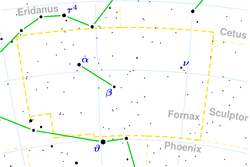Alpha Fornacis
| Observation data Epoch J2000 Equinox J2000 |
|
|---|---|
| Constellation | Fornax |
| Right ascension | 3h 12m 04.5277s |
| Declination | –28° 59′ 15.425″ |
| Apparent magnitude (V) | 3.85 |
| Characteristics | |
| Spectral type | F8IV |
| U−B color index | +0.082 |
| B−V color index | +0.581 |
| Astrometry | |
| Radial velocity (Rv) | –20.5 km/s |
| Proper motion (μ) |
RA: 371.49 mas/yr Dec.: 612.28 mas/yr |
| Parallax (π) | 70.24 ± 0.45mas |
| Distance | 46.4 ± 0.3 ly (14.24 ± 0.09 pc) |
| Details | |
| Mass | 1.33 ± 0.01 M☉ |
| Radius | 2.04 ± 0.06 R☉ |
| Luminosity | 4.87 ± 0.16 L☉ |
| Surface gravity (log g) | 4.27 cgs |
| Temperature | 6,240 K |
| Metallicity [Fe/H] | –0.20 dex |
| Rotational velocity (v sin i) | 3.9 km/s |
| Age | 2.9 Gyr |
| Other designations | |
| Database references | |
| SIMBAD | data |
Alpha Fornacis (α Fornacis, α For) is the brightest star in the constellation Fornax. It is the only star brighter than magnitude 4.0 in the constellation. It has the proper names Dalim (in Piazzi's Palermo Catalogue) and Fornacis (in Burritt's Atlas). This star was originally designated 12 Eridani.
The stellar classification of Alpha Fornacis is F8IV, where the luminosity class IV indicates this is a subgiant star that has just evolved off the main sequence. It has 33% more mass than the Sun and is an estimated 2.9 billion years old. Alpha Fornacis is a binary star and has a high proper motion. This system displays an excess of infrared emission, which may indicate the presence of circumstellar material such as a debris disk.
The secondary has been identified as a blue straggler, and has either accumulated material from, or merged with, a third star in the past. It is a strong source of X-rays and is 78% as massive as the Sun.
The space velocity components of this star are (U, V, W) = (–35, +20, +30) km/s. Approximately 350,000 years ago, Alpha Fornacis experienced a close encounter with the A-type main sequence star Nu Horologii. The two came within an estimated 0.265 ly (0.081 pc) of each other, and both stars have debris disks.
...
Wikipedia

